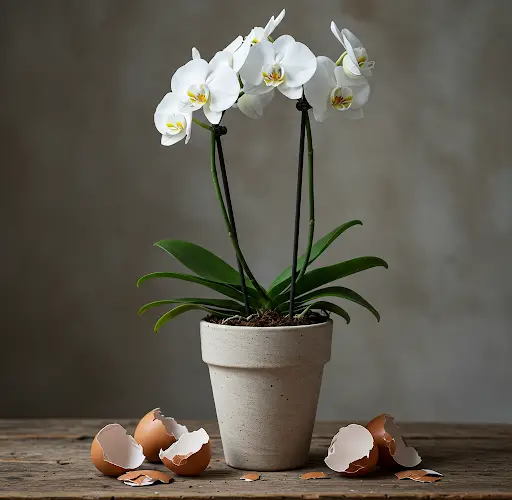How to Revive and Nourish Orchids with Natural Fertilizer
Orchids are delicate plants that require proper care to thrive and bloom beautifully. Over time, they may develop dry branches, weakened roots, or nutrient deficiencies that can affect their growth. However, with the right combination of natural fertilizers, including banana peels, eggshells, and rice water, you can rejuvenate your orchids and encourage them to produce vibrant flowers. This guide will walk you through the steps of pruning, treating, and feeding orchids for optimal growth.
Step 1: Pruning and Preparing the Orchid
The first step in orchid care is to remove any dry or damaged parts to promote healthy regrowth.
- Trim Dry Branches: Use sterilized scissors or pruning shears to carefully cut off all dry branches. This prevents the plant from wasting energy on non-viable parts.
- Apply Cement on Cuts: Lightly sprinkle cement on the freshly cut areas. Cement helps to seal the wound, preventing infections and promoting quick healing.
- Let It Rest: Allow the orchid to sit without watering for one full day. This ensures that the cuts dry completely, reducing the risk of rot or disease.
Step 2: Preparing a Nutrient-Rich Natural Fertilizer
To keep orchids healthy and encourage blooming, a combination of banana peels, eggshells, and rice water provides essential minerals.
Banana Peels for Nutrients
Banana peels contain important minerals such as potassium, phosphorus, and trace elements like magnesium and calcium, which nourish orchids and promote root development.
- Take 3 Banana Peels: Use fresh banana peels for maximum nutrient content.
- Cut into Thin Slices: This increases the surface area, allowing nutrients to be released more effectively when mixed with water.
Eggshells for Calcium
Eggshells are an excellent source of calcium, which helps plants develop strong stems and prevents issues like flower drop and root rot.
- Take 3 Chicken Eggshells: Wash and dry them thoroughly before use.
- Crush the Eggshells: Break them into small pieces to make it easier for nutrients to dissolve into the liquid fertilizer.
Rice Water for Essential Minerals
Rice water is packed with vitamins, amino acids, and minerals that improve plant health.
- Take 3 Spoons of Rice: Use uncooked white or brown rice for best results.
- Add 1 Liter of Water: Bring the water to a boil, then soak the rice in it.
- Let It Cool: Once the water cools, strain out the rice.
- Reserve the Water: Use this nutrient-rich liquid for your orchids.
- Soak Rice Water for Later Use: The strained rice water can be soaked in hot water again and used after a week for continuous nourishment.
Step 3: Applying the Natural Fertilizer to Orchids
Once the natural fertilizer is prepared, it needs to be applied in two ways: watering the roots and spraying the leaves.
Watering the Orchid (Once a Week)
- Mix the Nutrient Solution: Combine the banana peel, eggshell, and rice water mixture with clean water in a 1:1 ratio.
- Pour Around the Roots: Gently water the base of the orchid, ensuring that the roots absorb the nutrients efficiently.
Spraying the Orchid Leaves (Once a Week)
- Fill a Spray Bottle: Pour the liquid fertilizer into a spray bottle.
- Mist the Leaves Evenly: Spray both the top and bottom of the leaves. This helps orchids absorb additional nutrients while keeping the leaves hydrated.
Step 4: Maintaining the Orchid’s Health and Encouraging Growth
Following this routine consistently will significantly improve your orchid’s health over time.
After 1 Month:
- Continue Watering Once a Week: Regular watering ensures the orchid gets the nutrients it needs for steady growth.
- Continue Spraying Once a Week: This step strengthens the leaves and prevents pest infestations.
- Check Placement of the Orchid Pot: Ensure the orchid is positioned near a windowsill or under a sun filter to receive adequate light without direct exposure.
After 2 Months:
- New Buds and Flowers Begin to Develop: The orchid will start producing fresh flower buds, signaling improved health.
- Brighter and More Vibrant Flowers: Even if previous flowers have withered, newly bloomed ones will have richer colors.
Additional Tips for Orchid Care
To maintain long-term orchid health, follow these best practices:
- Avoid Overwatering: Ensure the potting mix is well-draining to prevent root rot.
- Provide Proper Light: Keep orchids in bright, indirect light to encourage blooming.
- Maintain Humidity Levels: Orchids thrive in humid environments, so misting or placing a humidity tray nearby can be beneficial.
- Monitor for Pests: Check leaves and roots regularly for any signs of pests or fungal infections.
- Use Organic Fertilizers Every 2 Weeks: Continue using banana peel, eggshell, and rice water fertilizer biweekly to sustain healthy growth.
Conclusion
By following these steps, you can revive, nourish, and encourage your orchids to bloom beautifully. The combination of natural fertilizers provides essential nutrients while maintaining a balanced environment for the plant. With proper pruning, fertilization, and care, even orchids with dry branches and wilted flowers can be rejuvenated, producing healthy leaves and vibrant flowers over time. Stick to this simple routine, and your orchids will continue to flourish with bright, colorful blooms for months to come.



